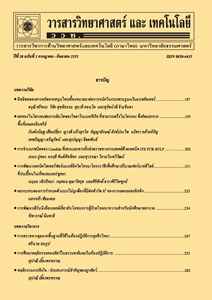การเปรียบเทียบผลของการออกกำลังกายในน้ำและบนบกต่อความดันโลหิตและองค์ประกอบของร่างกายในผู้ที่มีน้ำหนักเกินมาตรฐานและอ้วน
Main Article Content
Abstract
Abstract
The study aimed to compare the effect of aquatic exercise program and land-based exercise program on blood pressure and body composition in overweight and obese participants. Individuals who had body mass index between 25.0-34.9 kg/m2 and waist to height ratio > 0.5 were recruited. All participants were randomized into two groups: Aquatic exercise group (N = 25) and Land based exercise group (N = 25). Each group was asked to exercise 3 times a week for 4 weeks. Blood pressure and body composition were measured before and after training. The results found that, there were not significantly different in blood pressure and body composition between Aquatic group and Land based exercise group (p > 0.05). However, land-based exercise group presented statistically significant decrease in systolic blood pressure (p = 0.01), body fat percentage (p = 0.002) and subcutaneous fat percentage (p = 0.000) respectively, whereas muscle mass percentage presented statistically significant increase (p = 0.001). Therefore, there were not significant differences between groups. But, land-based exercise program decreased blood pressure body fat and subcutaneous fat and increased muscle mass in overweight and obesity.
Keywords: aquatic exercise; land-based exercise; overweight; obesity
Article Details
References
[2] Gibson, G.J., 2001, Obesity, respiratory function and breathlessness, Respiratory Med. 5: S41-S44.
[3] Fagard, R.H., 2002, Physical exercise and coronary artery disease, Acta Cardiol. 57: 91-100.
[4] World Health Organization, Obesity and over-weight, Fact sheets, Available Source: http://who.int/mediacentre/fact sheets/ fs311/en.
[5] Richard, N.R., 2009, Obesity related Hypertension, Ochsner J. 9: 133-136.
[6] ทัศพร สุดเสน่หา, 2556, ตัวแปรที่ส่งผลต่อพฤติกรรมการบริโภคอาหารของกลุ่มเสี่ยงโรคอ้วนลงพุงกรณีศึกษา : โรงพยาบาลส่งเสริมสุขภาพตำบลไผ่งาม อำเภอโคกสูง จังหวัดสระแก้ว, วิทยานิพนธ์ปริญญาโท, มหาวิทยาลัยเทคโนโลยีราชมงคลพระนคร, กรุงเทพฯ, 80 น.
[7] Jensen, M.D., 2006. Is visceral fat involved in the pathogenesis of the metabolic syndrome? human model, Obesity 14: 20-24.
[8] Critchley, D.J., Pierson Z. and Battersby G., 2011, Effect of pilates mat exercise and conventional exercise programmes on transverses abdominis and obliquus internus abdominis activity: Pilot randomized trial, Manual Therapy 16: 183-189.
[9] Cakmakci, O., 2011, The effect of 8 week pilates exercise on body composition in obese women, Coll. Antropol. 4: 1045-1050.
[10] Fagard, R.H., 2002, Physical exercise and coronary artery artery disease, Acta Cardiol. 57: 91-100.
[11] Wouters, E.J.M., Annemieke, M.A., Nunen, V., Geenen, R., Kolotkin, R.L. and Vingerhoets, J.M., 2010, Effects of Aquajogging in Obese Adults: A pilot study, J. Obes., Article ID 231074, 7 p.
[12] อนงค์นาท สนธิเทศ, รัฐวรรณ ปณิธิพร, ปวันรัตน์ จานทอง, สุกัลยา เจริญรัตน์จรูญ และกรอนงค์ ยืนยงชัยวัฒน์, 2559, ผลการเดินแบบจำนวนก้าวคงที่และการเดินแบบเพิ่มจำนวนก้าวต่อองค์ประกอบของร่างกายในผู้ที่มีภาวะน้ำหนักเกิน, ว.วิชาการสาธารณสุข 25: 831-839.
[13] ศศิภา บูรณพันธฤกษ์, ขนิษฐา วัฒนานนท์, ชนกนันท์ ภักดีกุล, กฤตวิทย์ แดงเพชร, กรอนงค์ ยืนยงชัยวัฒน์, ขจรศักดิ์ พงษ์พานิช และรุ่งชัย ชวนไชยะกูล, 2560, เปรียบเทียบผลระหว่างการออกกำลังกายในน้ำและบนบกต่อความแข็งแรงของกล้ามเนื้อหายใจและสมรรถภาพการทำงานของหัวใจและปอดในคนไทยที่มีภาวะน้ำหนักเกินและอ้วน, ธรรมศาสตร์เวชสาร 17: 28-40.
[14] Mertens, I.L. and Gaal, L.F., 2000, Overweight, obesity, and blood pressure: The effects of modest weight reduction, Obesity Res. 8: 270-278.
[15] วีรพัฒน์ ยอดมกลศาสตร์, 2550, การศึกษาเปรียบเทียบการใช้พลังงานของการออกกำลังกายเพื่อสุขภาพชนิดต่าง ๆ ระหว่างหญิงที่มีภาวะน้ำหนักเกินและหญิงที่มีน้ำหนักปกติ, วิทยานิพนธ์ปริญญาโท, จุฬาลงกรณ์มหาวิทยาลัย, กรุงเทพ, 152 น.
[16] Kolanowski, J., 1999, Obesity and hypertension: From pathophysiology to treatment, Int. J. Obes. 23: 42-46.
[17] Hall, J.E., 2000, Pathophysiology of obesity hypertension, Curr. Hypertens. Rep. 2: 139-147.
[18] สุพิมพ์ อุ่นพรม, นงนุช โอบะ และนุศรา วิจิตรแก้ว, 2550, ผลของโปรแกรมให้ความรู้ด้านสุขภาพต่อพฤติกรรมสร้างเสริมสุขภาพของประชาชนกลุ่มเสี่ยงโรคเบาหวานวัยผู้ใหญ่, ว.คณะพยาบาลศาสตร์ มหาวิทยาลัยนเรศวร 1: 100-109.
[19] สุนีย์ ปินทรายมูล, 2552, การศึกษาผลขงการปรับเปลี่ยนพฤติกรรมในการออกกำลังกายและการบริโภคอาหารที่เหมาะสมในนักเรียนประถมศึกษาที่มีน้ำหนักเกินมาตรฐาน, ว.วิจัยสาธารณสุขศาสตร์ มหาวิทยาลัยขอนแก่น 2: 10-21.
[20] Howley, E.T., 2000, Type of activity: Resistance, aerobic and leisure versus occupational physical activity, Med. Sci. Sport Exerc. 33: 364-369.
[21] Fagard, R.H. and Cornelissen, V.A., 2007, Effect of exercise on blood pressure control in hypertensive patients, Eur. Soc. Cardiol. 14: 12-17.
[22] Wu, T., Gao, X., Chen, M. and Vandam, R.M., 2009, Longterm effectiveness of diet plus exercise intervention vs. diet only intervention for weight loss: A meta-analysis, Obesity Rev. 10: 313-323.
[23] Boutcher, S.H. and Dunn, S.L., 2009, Factors that may impede the weight loss response to exercise-base intervention, Obesity Rev. 10: 671-680.
[24] นิรอมลี มะกาเจ, พรพล พิมพาพร และราตรี เรืองไท, 2555, ผลของการออกกำลังกายแบบพิลาทิสและแบบแอโรบิคที่มีต่อไขมันในช่องท้องในผู้หญิงอ้วน, น. 1419-1424, ใน การประชุมวิชา การแห่งชาติ มหาวิทยาลัยเกษตรศาสตร์ วิทยาเขตกำแพงแสน ครั้งที่ 9, นครปฐม.


